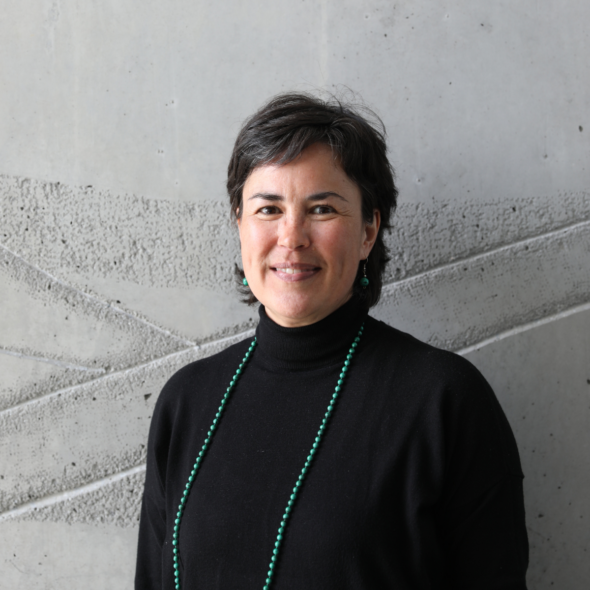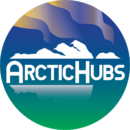Could you first tell us something about yourself and your role within ArcticHubs?
 I was employed as a social researcher at the Greenland Institute of Natural Resources (GINR) a year after the start of the ArcticHubs project. As the principal researcher in Nuuk looking at tourism and indigenous livelihoods, I have been most directly involving in introducing and applying for the first time in this context, the research methods such as PPGIS, Q-method and future scenarios and seeing how these tools fit to the situations around Nuuk hub.
I was employed as a social researcher at the Greenland Institute of Natural Resources (GINR) a year after the start of the ArcticHubs project. As the principal researcher in Nuuk looking at tourism and indigenous livelihoods, I have been most directly involving in introducing and applying for the first time in this context, the research methods such as PPGIS, Q-method and future scenarios and seeing how these tools fit to the situations around Nuuk hub.
With my affiliation to Nuuk, I have a broad professional network and with a Greenlandic mother and Danish father, I have a natural intercultural understanding and speak both Greenlandic and Danish. So, in many ways, involving stakeholders in a study of tourism and local Inuit in Nuup Kangerlua is in line with my professional profile.
What is the progress of your research within ArcticHubs now?
The data currently collected show that there are conflicts of interest in the use of fjords and land between local fishermen and hunters and tourism operators. But there are also examples of good working relationships and synergies between the various actors. However, it is repeatedly mentioned that there is insufficient involvement of local Inuit and traditional fishermen and hunters in the development of the tourism industry in Nuuk. This is even though several relevant legislations prescribe the involvement of locals in issues related to resource use.
Relevant legislations prescribe good coexistence between the various resource users, but In the study on trophy hunting at the bottom of Nuuk Fjord, a sub result shows that the participants do not want coexistence and that trophy hunting should be located away from the locals’ hunting sites. Several laws provide for opportunities for tourism activities to be attributed to some regulatory mechanisms to ensure a nature- and culture-friendly tourism development. But the question is whether the authorities can control the rapid development of tourism where the environment and culture are protected?
What do the initial findings of your current research say about the Nuuk area, its inhabitants and its future landscape?
Nuuk hub, which is Greenland’s capital, is currently exposed to extensive construction development initiatives and an increasing number of external interests knocking on the door. This puts pressure on the authorities and potential local business partners. The pressure to find good initiatives and potential solutions, is clearly experienced in my research collaboration with stakeholders.
Using the co-concept method with co-design of studies and co-production is a time and resource consuming process. But despite these challenges, we have received positive feedback from the stakeholders involved, who found it mutually rewarding with the use of the co-concept and the PPGIS tool in WP4.
I am aware of the competition for stakeholder involvement, not only in research activities, but also for many other collaborative projects.
With the low population in Greenland, it will not be easy to continue recruiting respondents for the upcoming research activities.
Which future challenges do you envisage for Nuuk region/area and Greenland, especially in the tourism sector in terms of sustainability?
Nuuk’s runway will be extended and in 2024 it will be converted into an international airport. There is therefore a desire for tourism to be further developed in Nuuk and new tourism revenues to help cover the construction costs.
Some tourism operators are keen to promote Nuuk as Greenland’s future tourism mecca. But sub results of WP3 and WP4 show that opinions are divided on this.
Some local fishermen and hunters, whether recreational or commercial hunters, are concerned about the increased user level of the fjord and land area. Some stakeholders are calling for increased control and regulation of tourism activities in order to preserve the area’s character as a wilderness area – with untouched nature.
In addition, no baseline studies have been carried out before on the natural and environmental status of the areas that are recently and in the near future zoned for tourism activities. So that environmental monitoring can begin to be carried out on an ongoing basis. Some believe that baseline studies and environmental monitoring are not yet relevant, as the level of tourism activity is low, while others are pushing and claiming rather too early than too late.
Why are the activities of ArcticHubs project important for local communities and Arctic stakeholders?
In the ArcticHubs project we use different survey methods, involving different local, but also regional and national stakeholders. The purpose of collaborating with stakeholders from different areas of authority, organisations and citizens is, among other things to co-create a cross-cutting and multi-faceted knowledge base and nuanced attitudes and proposals for nature- and culture-friendly sustainable tourism development.
In Nuuk hub, for example, we have in WP4, taken the initiative to collaborate with representatives from the municipality’s Planning Authority and Business Department, the Government of Greenland’s Ministry of Business, the 3 local fishing and hunting associations, as well as a local initiator for the development of hunting tourism in Nuuk Fjord.
The co-creation group held dialogue meetings that have provided relevant multi-faceted knowledge and nuanced opinions as well as suggestions for the design of a study on trophy hunting and concession area at the bottom of Nuuk fjord.
Overall, the dialogue meetings had the character of mutual interest, listening and commitment. Gratitude was expressed for the meetings, which created a better understanding of each other’s positions, insights and opinions. However, it is not always easy to accommodate and participate in a meeting where conflicts of interest are played out. It requires respect and recognition. A few expressions of frustration, reproaches and distancing attitudes were played out and acknowledged.
It was pointed out that,
as an authority representative you can only speak on behalf of the area of authority of the place of employment. Therefore, it was constructive that other authority representatives also participated and could express their views on the topic of conversation when it was within their area of authority. This broke the silo approach and promoted a holistic orientation and multi-faceted knowledge sharing.
A few government and association representatives had experience with dialogue meetings across sectors and associations. This is in line with several relevant legislations such as prescribing citizen involvement in land use planning, inclusion of hunter- and user knowledge in connection with the administration of hunting conditions, and general citizen involvement and public information in public consultation rounds. While others were limited by experience with stakeholder collaboration and co-creation of joint investigations.
How is your research setting the ground for current and future ArcticHubs activities?
The inclusion of different levels of knowledge and areas of knowledge is a complicated process. Especially if the knowledge collected is to be universal and representative, and not an expression of the opinion of individuals, the process is further complicated.
Much user knowledge, both contemporary and traditional, is not registered with the risk that it will not be used. In connection with the study on trophy hunting and concession area in Nuuk fjord, we have tried to involve representative contemporary user knowledge (which is based on traditional knowledge) and therefore active Inuit hunters from commercial and recreational hunters’ associations were also invited as partners.
Ideally, it is to co-create a multi-faceted knowledge base for the preparation of constructive and adaptive (modified as necessary) management plans with detailed provisions enshrined in relevant sectoral legislation.
However, a holistic approach, based on input from different areas of government and associations, is resource and time consuming. At times, it can be difficult to find the necessary time and resources for stakeholder involvement and joint meetings with constructive dialogue. Time and resource scarcity is found among government representatives, association representatives, researchers, and citizens. Especially in these times with many development initiatives, as well as global drivers that affect development initiatives in Nuuk hub.
We from the Greenland Institute of Natural Resources are grateful that the stakeholders involved participated engaged and rewarding, where we together moved through an open but demanding process. Together we created a multifaceted, but overarching, knowledge base and shaped nuanced proposals and ideas for a solution-oriented study. The process has been resource-intensive and in a future stakeholder collaboration, a better division of responsibilities and tasks will distribute the time and resource use between the partners involved and strengthen joint ownership.
Mapita, who participates as SME in the ArcticHubs project, has been greatly appreciated for their professional support with software and the development of an innovative and interactive design where the survey results are presented online and with the interactive feature the results can be commented on by the public. We are finding that the Maptionnaire tool has been most useful both now and for its potential in future activities flowing from the ArcticHubs project.
The Government of Greenland’s Department of Fisheries and Hunting has also asked for a presentation of the study and the method PPGIS. And there has been good media coverage of the PPGIS study with 3 radio interviews and an online newspaper article.
As a co-researcher in ArcticHubs, it is an honor to be involved in carrying out research activities based on the co-concept of co-design and co-production and experience that involved stakeholders not only invest with time, knowledge, and proposals, but also use the outcomes of the research activities.
Biography
I have a master’s degree in geography and communication and more than 20 years of teaching experience in the subject’s geography, nature science, communication and rhetoric at different educational levels.
In addition, I have been employed as an official in The Environmental Agency for Mineral Resource Activities and have experience with citizen involvement in the form of public dialogue meetings on mineral resource projects. I have also participated in statutory public consultation meetings on extraction projects together with elected politicians and experts. But the crucial thing is that I approached the project with curiosity and commitment. Happily it turns out that my personal and professional profile fits nicely into the ArcticHubs project!
